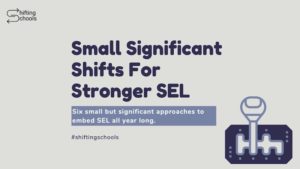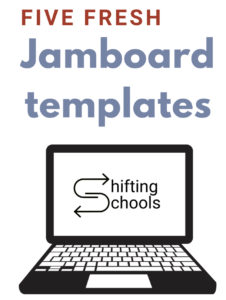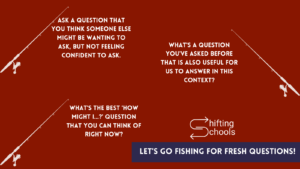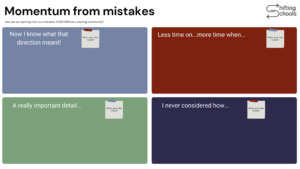
Blogs as Web Based Portfolios Part 1
(Part 1 of a series of blog posts to be made into a free PDF. Your feedback, ideas and thoughts are critical!)
The purpose of this PDF is to help schools looking at adopting Web Based Portfolios (WBP) as a form of assessment with students over a period of time. By adopting a web-based platform as a container in which to house portfolio content, schools give students a web-based vehicle with endless possibilities to create, collaborate and communicate their learning to the world.
 Web Based Portfolios have been gaining ground in recent years as the skills needed to create digital content have become less complex. Remember the days when a digital portfolio meant courses in Dreamweaver or some other programing language? Those days are behind us as the tools of the web have taken over and simplified things to a point where a true Web Based Portfolio is possible.
Web Based Portfolios have been gaining ground in recent years as the skills needed to create digital content have become less complex. Remember the days when a digital portfolio meant courses in Dreamweaver or some other programing language? Those days are behind us as the tools of the web have taken over and simplified things to a point where a true Web Based Portfolio is possible.
In the past, schools, teachers and even students had to decide what their portfolio was going to reflect. Was it going to be a portfolio that showed assessment for learning or assessment of learning? The decision had to be made because in a paper-based world you just did not have enough space to physically hold all of the content to show both. In fact, in a paper-based world many teachers and schools started out envisioning their portfolios as a way to reflect on assessment for learning. In many cases, due to physical requirements in holding the amount of paper it took to show the learning process, many teachers and students ended up creating portfolios that showed assessment of learning. When a choice has to be made because of limited space to keep a rough draft or a final copy students will keep the final copy, and so will teachers.
WBPs if nothing else, solve this age old portfolio issue. With the cost of servers and web storage continuing to drop, creating endless storage space for students to show the learning process and allowing teachers to assess for learning is cheap and getting less expensive every day.
When students have endless space, a WBP not only shows assessment for learning, but also assessment of learning. We now have a vehicle that has the space to allow students and teachers to have the best of both worlds all in one place and the ability to track learning over great lengths of time.
 The biggest issue a WBP solves is an issue that, up until now, we could not even talk about because we did not have a vehicle that allowed us to even have the discussion.
The biggest issue a WBP solves is an issue that, up until now, we could not even talk about because we did not have a vehicle that allowed us to even have the discussion.
When we talk about assessing learning over time, or tracking learning over time, historically schools have done a good job of tracking assessment for learning year by year. Students come into 3rd grade, keep a portfolio of their work, and at the end of that year take their work home with them. The next year they come back as 4th graders and repeat the process all over again.
Education never had a system that allowed educators to look at learning year after year other than maybe a few teacher picked samples to go into a student cumulative folder. Of course these cumulative folders are better at giving us a snapshot and focus on assessment of learning not for learning in the long run.
With a WBP that belongs to the student, controlled by the student, created by the student, education now has a vehicle that can extend beyond space and time of a school year. Once a student creates a WBP and owns that space, the assessment for learning over a long period of time becomes natural. Students have one spot, with unlimited space to create, gather, and reflect on their own learning.
Think of the possibilities as a 7th grade teacher if you had students who were in your school system for four years and were able to look back at how they progressed as a reader. Students would have the ability to reflect on their growth as a mathematician from 3rd grade to 7th grade. The power of reflecting on one’s own learning across grade levels not just within them is something that until WBP, was a difficult if not an impossible task. I can imagine a day when a senior in high school has a body of knowledge all in one place that is his or her learning journey. Think of the wealth of information that would be contained within that portfolio. Think of the wealth of knowledge for the school to be able to track learners over time looking at a particular student as a learner.
This would never be possible in a paper-based world. The amount of information, knowledge, and understanding that would be in that one portfolio would not be able to be stored in a paper-based world…now think of all the students in your school or district. The paper-based world can not compete.
WBPs not only solve some of our biggest frustrations as educators but they create new opportunities that we haven’t even thought of tapping into yet.
 A critical shift in moving to a WBP system is the notion that students own the portfolio. This, I believe, is a huge shift in the way we view portfolios. For many educators this will be a scary step. When students own their own learning, when they are able to reflect on their own learning, have some choice on what their portfolio looks like, acts like, and when they are able to update it anytime and anywhere, the control of the content shifts from the teacher to the student.
A critical shift in moving to a WBP system is the notion that students own the portfolio. This, I believe, is a huge shift in the way we view portfolios. For many educators this will be a scary step. When students own their own learning, when they are able to reflect on their own learning, have some choice on what their portfolio looks like, acts like, and when they are able to update it anytime and anywhere, the control of the content shifts from the teacher to the student.
Otherwise known as student-centered learning, students become the true drivers of the content that is put within their WBP. The WBP reflects who they are as a learner. With the guidance of the teacher, students make choices on what learning artifacts deserve more attention than others and find ways to make those artifacts stand out (assessment of learning). In this way you have assessment of learning embedded within, surrounded by assessment for learning, which creates a learning assessment ecosystem that is rich with data, content, and reflections.
Many portfolio initiatives in schools stem from Student-Led Conferences. The Student-Led Conference, or conference format in which the student and student learning is the center of the conference, have gained momentum in the last decade and usually include a portfolio of learning.
As an elementary teacher I know the drill: Conferences are fast approaching and you realize you haven’t had the students working on their p
ortfolios for the upcoming conferences. You drop everything, and for two weeks focus strictly on creating portfolios. 3 reading examples with reflections, 2 writing pieces with reflections, 2 math papers, a spelling test, a piece of art, and the list goes on.
 Portfolios are created for conferences, not necessarily to truly reflect student learning. WBPs allow content to easily be collected throughout the school year. Students might take a picture of their work, or something that represents their work, and put it in their portfolio. They might reflect on ten assignments, create and embed two videos, record themselves reading twice and write a reflection about it and upload all of it to their WBP.
Portfolios are created for conferences, not necessarily to truly reflect student learning. WBPs allow content to easily be collected throughout the school year. Students might take a picture of their work, or something that represents their work, and put it in their portfolio. They might reflect on ten assignments, create and embed two videos, record themselves reading twice and write a reflection about it and upload all of it to their WBP.
Come conference time, the student creates a new category or tag called “conference 2010”. They then categorize or tag the content they want to show at the conference and are able to choose from a wealth of information-anything they want to show. They might in fact, show a sample of writing from 5th grade and one from 7th grade, demonstrating to their parents how they have grown as a writer over time. Or they may choose an audio recording of themselves reading as a 3rd grader not pronoucing their Rs correctly and then in 7th grade reading with emotion and having a great laugh about how far they have come and what they have worked on as a reader over time.
When we separate the WBP from the conference, it becomes a true vehicle of assessment for learning. With a WBP, educators can think about learning over time, in ways never before possible. We can find ways for students to deeply reflect on their own learning and allow students to truly own their learning. WBPs not only solve many of the issues that paper-based portfolios had, they create whole new assessment and reflection opportunities educators have only dreamed of.








Thanks Jeff
Great ideas there and I really liked the part about how much more meaningful something like a reading log would be if it was tracked so easily as it would be on an ongoing blog.
Teachers performance portfolios have been due this month and I am bewildered at how many teachers still maintain huge paper folders when our whole Elementary Staff now have their own blog.
Still really impressed with blogging here and amazed everyday at how naturally my students have taken to it, I have some fantastic kids this year and it is wonderful to see them creating their own online identity.
Kimbra
Love the convergence possibilities of this idea. Any suggestions of sites that would be most user-friendly for online portfolios? Given Ning’s crossing-over-to-the-pay-site status, might there be another site that would be ideal?
It’s coming in later parts. We’ll get there but wanted to start with the theory side of things. 🙂
I think that web based portfolio’s are useful and can be effective. Your ideas are great. That sort of what this class is like now. We had to create a blog and our homework was weekly blog post, it’s a lot of work but It helps us to make sure that our work is done properly because it’s viewable by the whole world.
My name is Sheree Orso. I am a student at the University of South Alabama in Mobile, Alabama. I was assigned to comment on your blog for Dr. Strange’s EDM310 class.You can view my blog at orsoshereeedm310.blogspot.com
Thanks for this post Jeff. Very timely for me as I mold my presentation on ePortfolios for two charter schools next week. I’ve used blogging as an example of a learning resource or reflection tool, but not as the portfolio. Makes a lot of sense – K.I.S.S!! I like the notion of ownership – let the kids figure out what it looks like. I’m giving teachers some recipes, so to speak, but I think its good to give kids the option of using their own knowledge to build a personal portfolio.
I think portfolios are very powerful in teaching students RESPONSIBLE sharing on the web. They know how to post via Facebook and Twitter. With projects like this, we can help them learn to use the web as means to showcase their talents and growth.
[…] Blogs as Web-Based Portfolios Part 2 May 3, 2010 By Jeff Utecht Share Hello there! If you are new here, you might want to subscribe to the RSS feed for updates on this topic. (Part 2 of a series of blog posts to be made into a free PDF. Your feedback, ideas and thoughts are critical! Part 1) […]
[…] http://www.thethinkingstick.com/blogs-as-web-based-portfolios-part-1 […]
[…] http://www.thethinkingstick.com/blogs-as-web-based-portfolios-part-1 […]
[…] a series of blog posts to be made into a free PDF. Your feedback, ideas and thoughts are critical! Part 1 & Part 2) Options for a WBP Blogging System There are three different ways you can build a WBP […]
[…] of the points I’ve been making in my series of blog posts on blogs as Web-Based Portfolios (1, 2 and 3) come through in this video. It always makes me feel good when I see that others are […]
[…] Blogs as Web Based Portfolios Part 1 | The Thinking Stick (tags: portfolios portfolio web2.0 blog blogs e-portfolios web) […]
[…] my Resources page for more on blogs, or start with the invaluable information The Thinking Stick blog presents for educators. blog comments powered by Disqus var disqus_url = […]